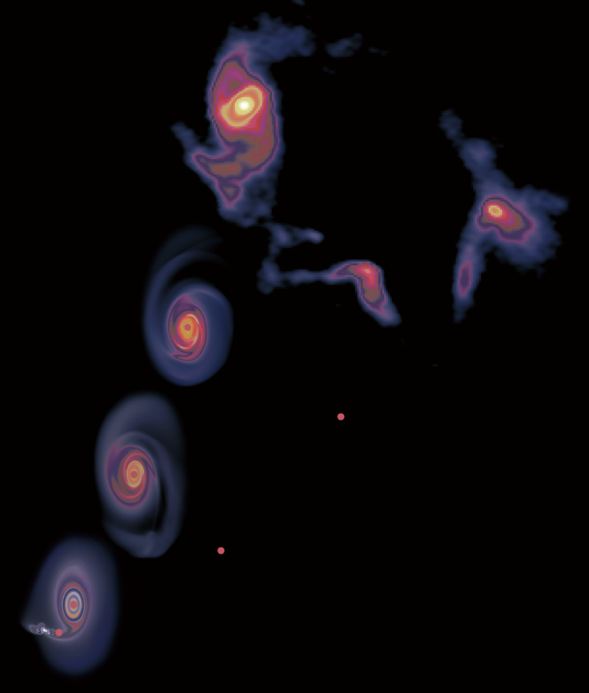This Mysterious Spiraling Star Looks Just Like a Mini Milky Way Galaxy

"Hearst Magazines and Yahoo may earn commission or revenue on some items through the links below."
A spiraling star just 26,000 light years away resembles a miniature galaxy.
It’s an unusually massive disk protostar, something scientists didn’t think was possible.
The spiraling was caused by a “close flyby” of another object thousands of years ago.
Astronomers have found an odd, but not uncommon, kind of star in a special part of the Milky Way galaxy. In new research based on sightings from the Atacama Large Millimeter Array (ALMA) telescope in Chile, the researchers say they’ve discovered a star that’s surrounded by a spiraling protostellar disk, a kind of swirling primordial space sludge that helps to nourish the star in its youth. Weirdly, it appears to be a miniature, galaxy-like spiral inside our own spiral galaxy. A star like this has never been seen so close to Earth, just 26,000 light years away.
The ALMA telescope is actually an array of 66 different radio telescopes that work in tandem to fulfill shared goals. In this case, a team of four scientists who work in China, Germany, and the United States aimed ALMA at a part of the Milky Way galaxy called the Central Molecular Zone (CMZ). This region has unusual properties compared with its surroundings in the rest of the Milky Way. Star formation in some gaseous parts of the CMZ is remarkably suppressed compared to the rest of the neighborhood, another team of researchers wrote in 2017.
That’s wild to think about—fewer new stars by a factor of more than ten times, the researchers pointed out. Scientists theorize that it’s because the CMZ is made of far denser gas, with an overall profile that behaves differently under spectroscopy than the rest of the “galactic disk” of the Milky Way. (Spectroscopy is a field that measures and interprets spectra produced when matter interacts with or emits electromagnetic radiation).
The temperature also varies wildly in the CMZ, from almost absolute zero (the lowest possible temperature, at which particles barely move) to hundreds of degrees Fahrenheit. Stars, once they exist, are variable and tough and often much, much hotter than that—but this is when they’re trying to emerge from the sky sludge by accumulating into a collected mass.
🌟Learn More About Stars With Us
So in the CMZ, far fewer stars emerge than in a similarly-sized area elsewhere in the galaxy. And maybe that factors into finding special and weird stars there, where other stars are less likely to disturb them. Sure, we’ve all thought about a tree that falls in the forest with no one there to hear it. But what about a tree that stands alone, totally undisturbed even by other trees, for thousands of years?
Stars with their protostellar disks attached are pretty common around the galaxy—after all, every star must begin somewhere. Our universe is dotted with an incredible array of things in every possible phase of their development, from the swirling clouds that will eventually bear stars, to the long-dead cloudy remnants of other stars.
Yet, it’s uncommon to see them this close to Earth. The star itself is 32 times as massive as our sun and the protostellar disk extends to a full diameter of 4,000 times the distance from the sun to Earth.

But its closeness isn’t the puzzling thing. It’s the fact that the star appears to spiral, like the central figure in a tiny galaxy of its own. Now, the team of scientists have put forward their explanation for how the protostellar disk turned into a spiral, because they’ve identified a relatively nearby object three times the size of the sun that they believe brushed past the protostellar disk. This “close flyby” agitated the protostellar disk, sending it into a spiraling pattern that has likely lasted for many thousands of years. The new paper appears in Nature Astronomy.
There’s something else cool here. Researchers have long studied and speculated about the nature of star formation. The process of spinning dust eventually accumulating and becoming a star has only been observed for small stars—ones closer to the mass of our sun. The researchers wondered if disks like these could form really large stars, even eight times the mass of our sun, or if massive stars are formed by other means. ALMA has already settled that question for us, and now the scientists have evidence that even more massive stars, 30-plus times the mass of the sun, can also be formed by the disk method.
These amazing discoveries are possible because the high-powered ALMA telescope is able to reveal an astonishing amount of detail, even 26,000 light years away in the heart of our galaxy. And because of the extreme conditions within the CMZ, it’s possible we’re only at the beginning of our journey discovering the weird and lovely stars within.
You Might Also Like

